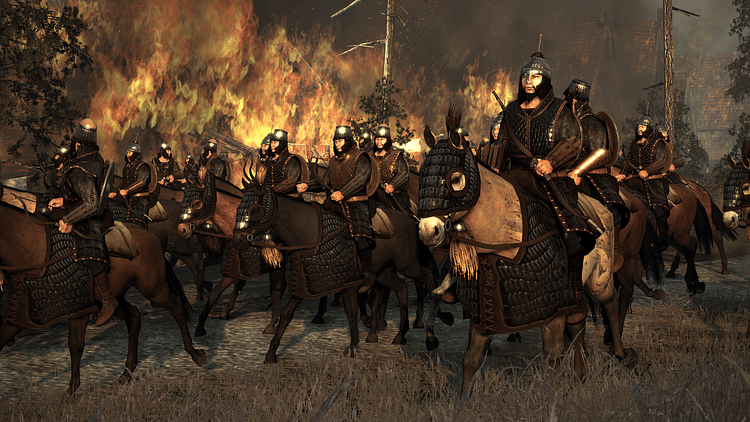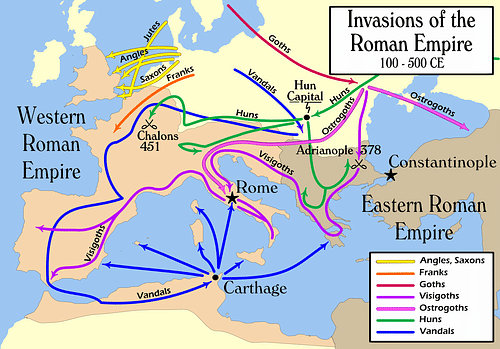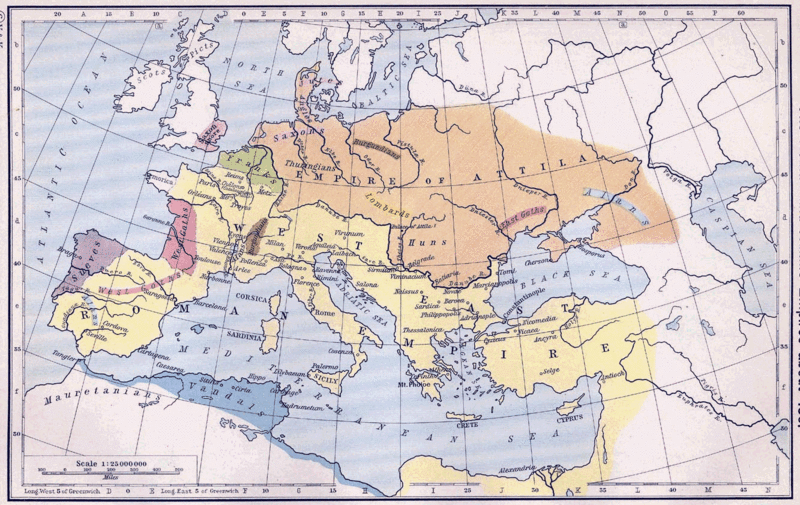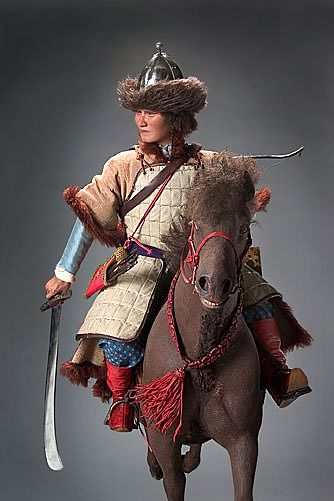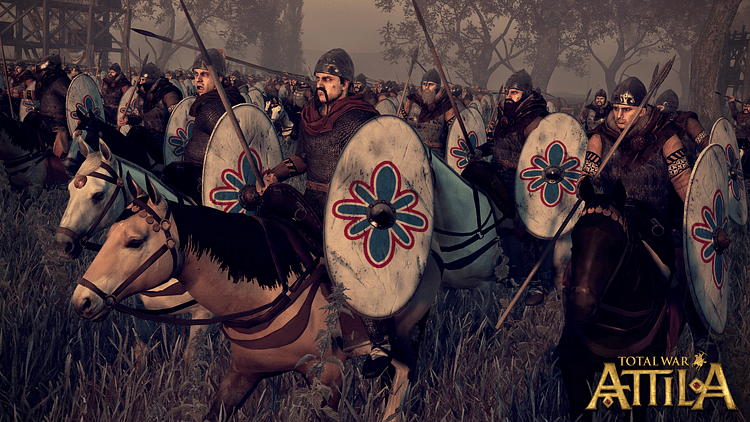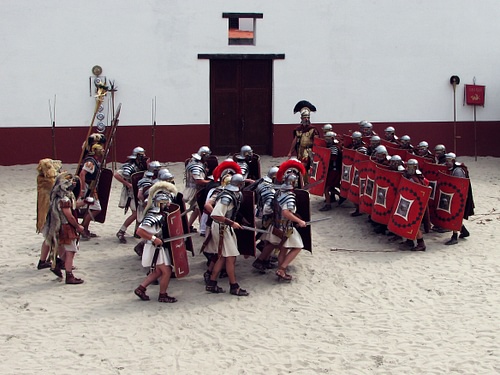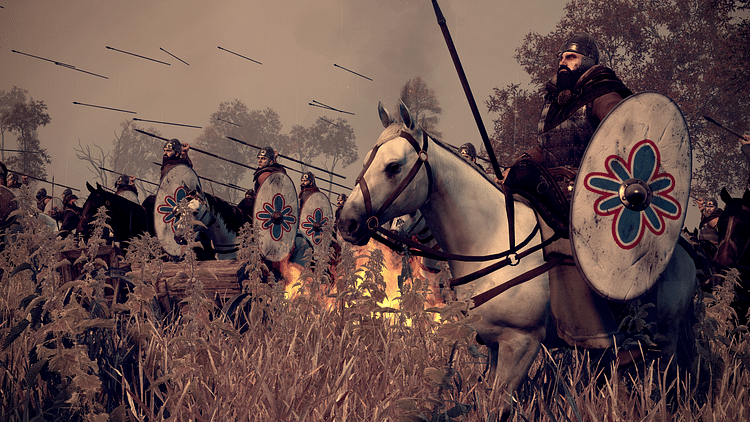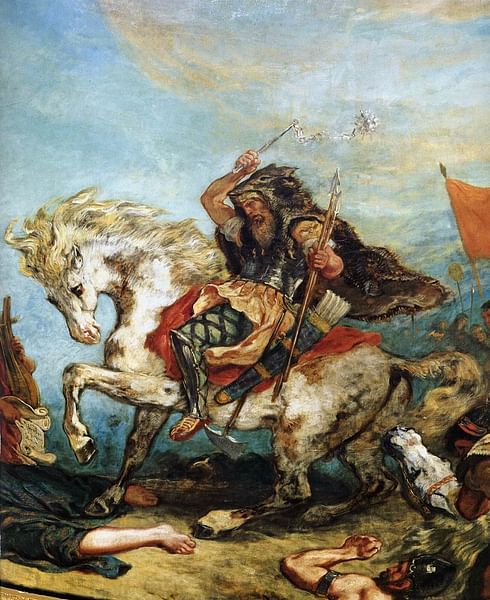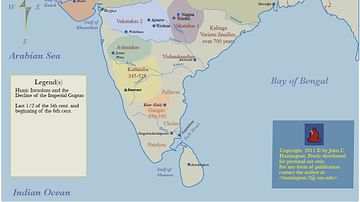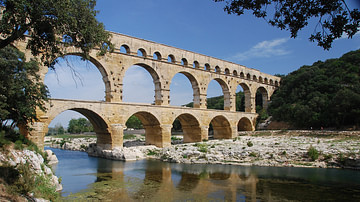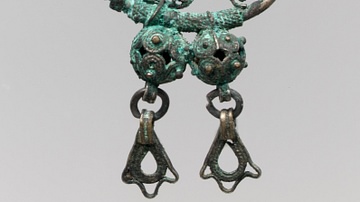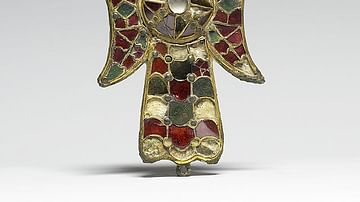The Battle of the Catalaunian Fields (also known as The Battle of Chalons, The Battle of Maurica) was one of the most decisive military engagements in history between the forces of the Roman Empire under Flavius Aetius (391-454 CE) and those of Attila the Hun (r. 434-453 CE). The conflict took place on June 20, 451 CE in Gaul (modern day France) in the Champagne region. Although the exact site of the battle has never been determined, it is known that the Catalaunian Fields were somewhere between the city of Troyes and the town of Chalons-sur-Marne. Although 20 June 451 CE is the most widely accepted date for the battle, other dates - as late as 27 September of the same year - have been proposed. The 20th of June is the most likely, however, based on the events preceding it - such as the siege of Orleans - and those which followed after.
The event is significant for a number of reasons, not the least of which is that it stopped the Hunnic invasion of Europe and so preserved the culture. The battle was also the first time European forces were able to defeat the Hun army and keep them from their objective. Although he would regroup and invade Italy the following year, Attila's aura of invincibility evaporated after Chalons, and he would actually concede and withdraw from Italy the following year. Two years after the Battle of the Catalaunian Fields, Attila was dead and his sons, who inherited his empire, fought with each other for supremacy. A mere 16 years after Attila's death, the vast empire he had created was gone and most scholars point to the Battle of the Catalaunian Fields as the pivotal moment when Attila's fortunes reversed.
Background of the Battle
The Roman Empire had been struggling to maintain cohesion since the Crisis of the Third Century (also known as The Imperial Crisis, 235-284 CE) marked by rampant social unrest, civil war, and the fracturing of the empire into three distinct regions (the Gallic Empire, the Roman Empire, and the Palmyrene Empire). Emperor Diocletian (284-305 CE) reunited these entities under his rule but found the empire so vast and difficult to rule effectively that he divided it into the Western Roman Empire with the capital at Ravenna and the Eastern Roman Empire whose capital was Byzantium (later Constantinople). Between the years c. 305 and c. 378 CE these two halves of the empire managed to maintain themselves and assist each other when necessary, but after the Battle of Adrianople on 9 August 378 CE, in which the Goths under Fritigern defeated and destroyed the Roman forces under Valens, Rome's struggles became more difficult.
At this same time, in the latter part of the 4th century CE, the Huns had been dislodged from their homeland in the region of Kazakhstan by the Mongols, and their initial displacement soon took on the form of an invading force living off the lands and destroying the populace of whatever regions they came into. In 370 CE they conquered the Alans; by 376 CE they had driven the Visigoths under Fritigern into Roman territory and by 379 CE those under the leadership of Athanaric to the Caucalands. The Huns continued their invasion of the region, and as historian Herwig Wolfram writes, citing the ancient source of Ambrose, the chaos this caused was widespread: "the Huns fell upon the Alans, the Alans upon the Goths, and the Goths upon the [tribes of] the Taifali and Sarmatians" (73). Many of these tribes, besides the Goths, sought refuge in Roman territory.
The Roman army had consisted largely of non-Romans since 212 CE when Caracalla granted universal citizenship to all free peoples within the boundaries of the Roman Empire. Service in the army once conferred citizenship on non-Romans, but after Caracalla, this was no longer an incentive and the military had to recruit soldiers from beyond Rome's borders. The Huns were frequently employed by the Roman army along with other non-Roman barbarians so there were Huns serving Rome while other Huns were invading its territories.
The invading Huns seemed to have no other objective than destruction and looting, and Rome had no means of fighting off a force which seemed to appear out of nowhere to ravish the land and then vanish as quickly as they had come. In 408 CE the chief of one group of Huns, Uldin, completely ransacked Thrace, and as Rome could do nothing to stop them militarily, they tried to pay them for peace. Uldin, however, demanded too high a price, and so the Romans opted to buy off his subordinates. This method of keeping the peace was successful and would become the preferred practice for the Romans in dealing with the Huns from then on. Still, as great a threat to Roman peace as the Huns were, they had no strong leader with a clear objective until Attila came to power.
Attila took control of the Hunnic forces when his uncle Rua died in 433 CE. Along with his brother, Bleda (also known as Buda), Attila made clear that Rome was now dealing with an entirely new enemy whose vision included a vast Hunnic empire. Attila and Bleda brokered the Treaty of Margus in 439 CE which, in part, stipulated that the Huns would not attack Roman territories in exchange for a large monetary sum. The Huns busied themselves in attacking the Sassanids for a time but, after they were repulsed in numerous engagements, turned back toward Rome. The Romans, meanwhile, believing that Attila would honor the treaty, had withdrawn their troops from the Danube region and sent them against the Vandals who were threatening Roman interests in North Africa and Sicily. Once Attila and Bleda realized that the region was virtually undefended, they launched their Danube Offensive in 441 CE, sacking and looting the cities at will.
Their offensive was all the more successful because it was completely unexpected. The Eastern Roman Emperor Theodosius II had been so confident that the Huns would keep the treaty that he refused to listen to any council that suggested otherwise. US Army Lt. Col. Michael Lee Lanning comments on this, writing:
Attila and his brother valued agreements little and peace even less. Immediately upon assuming the throne, they resumed the Hun offensive against Rome and anyone else who stood in their way. Over the next ten years, the Huns invaded territory which today encompasses Hungary, Greece, Spain, and Italy. Attila sent captured riches back to his homeland and drafted soldiers into his own army while often burning the overrun towns and killing their civilian occupants. Warfare proved lucrative for the Huns but wealth apparently was not their only objective. Attila and his army seemed genuinely to enjoy warfare, the rigors and rewards of military life were more appealing to them than farming or attending livestock. (61)
Shortly after the Danube Offensive, in 445 CE, Attila had Bleda assassinated and took complete control as supreme leader of the Huns. Attila viewed Rome as a weak adversary, and so, starting in 446 or 447 CE, he again invaded the region of Moesia (the Balkan area), destroying over 70 cities, taking survivors as slaves, and sending the loot back to his stronghold at the city of Buda (possibly Budapest) in present-day Hungary. Attila had now all but defeated the Eastern Roman Empire on the field and in diplomatic negotiations and so turned his attention to the west. He required a legitimate excuse for an invasion, however, and found one in a very unlikely ally.
In 450 CE, the Western Roman Emperor Valentinian's sister, Honoria, was trying to escape an arranged marriage with a Roman senator and sent a message to Attila, along with her engagement ring, asking for his help. Although she may never have intended anything like marriage, Attila chose to interpret her message and ring as a betrothal and sent back his terms as one-half of the Western Empire for her dowry. Valentinian, when he discovered what his sister had done, sent messengers to Attila telling him it was all a mistake and there was no marriage proposal and no dowry to be negotiated. Attila asserted that the marriage proposal was legitimate, that he had accepted, and that he would be coming to claim his bride. He mobilized his army and began his march toward the Roman capital.
The Adversaries
The Roman general Aetius had been preparing for a full-scale invasion of the Huns for some years prior to the event. Aetius had lived among the Huns as a hostage in his youth, spoke their language, and understood their culture. He had employed the Huns in his army many times over the years and had a personal and amicable relationship with Attila. Aetius is often described in keeping with the Roman historian Procopius' line that he "was the last true Roman of the West" (Kelly, 8). His contemporary, Rufus Profuturus Frigeridus, describes him:
Aetius was of medium height, manly in his habits and well-proportioned. He had no bodily infirmity and was spare in physique. His intelligence was keen; he was full of energy; a superb horseman, a fine shot with an arrow and tireless with the lance. He was extremely able as a soldier and he was skilled in the arts of peace. There was no avarice in him and even less cupidity. He was magnanimous in his behaviour and never swayed in his judgement by the advice of unworthy counsellors. He bore adversity with great patience and was ready for any exacting enterprise; he scorned danger and was able to endure hunger, thirst, and loss of sleep. (Devries, 209)
Although this description is obviously idealized (Aetius actually was capable of great avarice and cupidity), Aetius was the wisest choice to lead a force against the Huns. He knew their tactics and their leader, first of all, but his personal charisma and reputation for bravery and victory were essential in gathering enough soldiers to repel the invasion. Even with Aetius' personal and professional assets, however, he most likely was only able to assemble a force of some 50,000 men and needed to ally himself with a former adversary, Theodoric I (418-451 CE) of the Visigoths. He was able to muster an infantry made up largely of Alans, Burgundians, Goths, and others.
Attila is described by the historian Jordanes (6th century CE), who wrote the only ancient account of the Goths still extant and includes the Goth's interaction with the Huns. He describes Attila in a flattering light although he had no love for the Huns:
He was a man born into the world to shake the nations, the scourge of all lands, who in some way terrified all mankind by the rumors noised abroad concerning him. He was haughty in his walk, rolling his eyes hither and thither, so that the power of his proud spirit appeared in the movement of his body. He was indeed a lover of war, yet restrained in action; mighty in counsel, gracious to suppliants, and lenient to those who were once received under his protection. He was short of stature, with a broad chest and a large head; his eyes were small, his beard was thin and sprinkled with gray. He had a flat nose and a swarthy complexion, revealing his origin. (Jordanes, 102)
Attila is often depicted as the bloodthirsty "scourge of god" and uncivilized barbarian of the majority of Roman works on the subject, but some such as Jordanes' account and that of the Roman writer Priscus show him as a keen observer of others, a brilliant and charismatic leader, and a general of exceptional ability.
In 451 CE, Attila began his conquest of Gaul with an army of probably about 200,000 men, although sources, such as Jordanes, set the number higher at half a million. They took Gallia Belgica province (modern-day Belgium) with little resistance. Attila's reputation as an invincible force leading an army which neither asked for nor gave any mercy sent the populace of the regions fleeing as quickly as they could with whatever they were able to carry. Attila sacked towns and cities and moved on to ravage the land further.
The only time Attila had been turned back from a conquest was by the Sassanids - an event the majority of the people of Rome were unaware of - and his reputation for slaughter and invincibility preceded him as he moved through Gaul. In May, Attila reached the city of Orleans, which its king, Sangiban of the Alans, planned to surrender to him. Sangiban had never been able to reach Attila with this message, however, and the Huns lay siege to the city.
Aetius and Theodoric arrived at Orleans in time to disperse Attila's forward ranks, break the siege, and compel Sangiban to join them. Attila withdrew to the north to find ground more to his liking, leaving behind a contingent of 15,000 Gepid warriors to cover his retreat; according to Jordanes, this force was completely destroyed in a night attack orchestrated by Aetius, who then followed after Attila. Jordanes' account of the massacre of the Gepid forces has been challenged on a number of points, most notably the number of men Attila left behind, but most likely some contingent of his army was positioned to cover his withdrawal from Orleans and Aetius would have had to remove them from the field to follow.
The Battle of the Catalaunian Fields
Attila chose a site near the Marne River, a wide plain which he positioned his men across, facing north, his headquarters in the center and toward the rear. He placed his Ostrogoth forces to his left, and what was left of his Gepid troops to his right; his Hun warriors would take the center. Aetius arrived on the field after Attila was already in position and placed Theodoric and his forces opposite the Ostrogoths of the Huns, Sangiban and his army in the center, and took the far position opposite the Gepids.
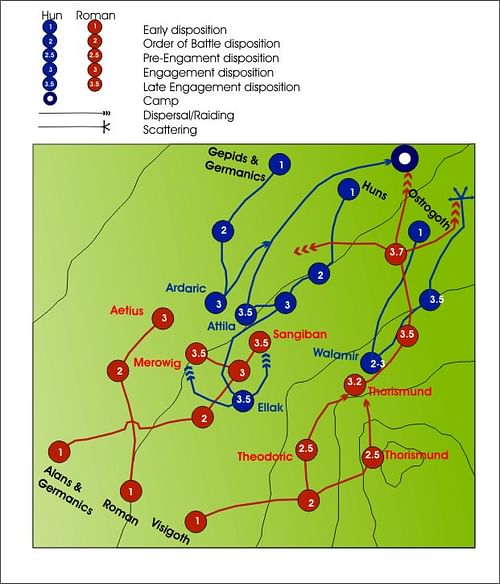
Although Attila had reached the field first, he chose a position on the lower part of the field, most likely thinking to draw the Roman forces down and make the most of his archers and cavalry. Lanning writes:
Relying on mobility and shock effect, Attila rarely committed his soldiers to close, sustained combat. He preferred to approach his enemy using the terrain to hide his troops until he was within arrow range. While one rank fired at high angles to cause the defenders to raise their shields, another fired directly into the enemy lines. Once they had inflicted sufficient casualties, the Huns closed in to finish off the survivors. (62)
The cavalry frequently made use of nets which they cast over an opponent, immobilizing him, and either killing him or leaving him for another and moving on. The terrain of the lower ground may have provided the kind of space and coverage which would have worked best to Attila's advantage, but since the exact location of the battle has never been determined, one cannot say for sure why he made his choice.
The Roman forces took the high ground, and between them and the Huns was a ridge which would have afforded an advantage to whichever side held it. According to Jordanes, Attila waited until the 9th hour (2:30 pm) to begin the battle so that, should the day go against him, his army could retreat under cover of darkness. While this may be, it is also possible that Aetius and his forces were not in position until about that time.
The Huns had tried to take the ridge in the center of the field earlier in the day (the reports only give 'morning' but no specific time) but were driven back by the Visigoths under Thorismund, son of Theodoric. The Visigoths held the ridge when the Huns launched their full attack in the afternoon. Sangiban and the Alans held the center against the Huns while the Visigoths engaged the Ostrogoths, driving them back. Theodoric was killed in this engagement, but contrary to the Hun's expectations, this did not demoralize the Visigoths but only made them fight harder.
Historian Kelly Devries cites Jordanes' account that the battle "grew fierce, confused, monstrous, unrelenting - a fight whose like no ancient time has ever recorded" (214). Jordanes goes on to repeat the old elders' first-hand reports that "the brook flowing through the battlefield was greatly increased by blood from the wounded soldiers flowing into it" (Devries, 214). Aetius and his forces were held in place by the Gepids but managed to separate them from the rest of the Hun force. Once the Ostrogoths were defeated by the Visigoths on the left flank, the Visigoths then descended on the Huns in the center. Unable to make use of either his cavalry or his archers, with his left flank in ruins and his right engaged with Aetius, Attila recognized his precarious position and ordered a retreat back to camp. The Gepids joined the retreat, and the entire Hun force moved, with the Roman forces still engaging them, steadily back until they were driven from the field; they did not reach their basecamp until after nightfall. Once secure in their camp, Hun archers were able to drive off the attackers and the battle came to a close.
That night, the sources relate, was one of complete confusion among the Roman ranks as soldiers - Aetius among them - stumbled about in the dark not knowing who had won the day or what they were supposed to do next. Aetius was allegedly so disoriented by the day's battle that he became lost and almost wandered into the Hun encampment. When dawn broke the next day, however, the full scale of the battle and the massive number of casualties was clear. As the historian Paul K. Davis writes, "When first light arrived, both sides were able to view the carnage of the previous day's fighting and neither seemed eager to renew it" (90). The Hun archers continued to keep their opponents at bay and made some feints at attack but never moved from the camp. Aetius and Thorismund recognized that the Huns were cowed and that the Roman forces could continue to hold the Huns in their position indefinitely until they surrendered; they thus began preparations for a siege surrounding the camp.
Aetius found himself in an uncomfortable position, however. The Visigoths under Theodoric had only joined his cause because they felt the Huns were a greater threat than Rome. If the Huns were eliminated, there was no longer a reason for the alliance, and Aetius feared that Thorismund and his much stronger force might turn on him, win easily, and march on toward Ravenna. He, therefore, suggested to Thorismund that he, Aetius, could handle what was left of the Hun forces and that Thorismund should return home with his troops, now that he was the new king of the Visigoths, to consolidate his power and prevent any of his brothers trying to usurp the throne in his absence. Thorismund agreed to this proposal and left the field. Aetius, alone now with his loosely organized force, gathered them under his command and quietly left the field as well. Attila and his forces remained in their basecamp, still waiting for an attack that never came, until they sent out scouts who informed them that their opponents were gone.
Although there was now no one to oppose him, Attila withdrew from Gaul and went back home. No satisfactory answer has ever been given to explain this, but some scholars, such as J.F.C. Fuller, believe that Aetius and Attila struck a bargain. Fuller writes:
The conditions at Ravenna were such that Aetius could feel safe only as long as he was indispensible, and to remain so it was necessary that Attila should not be crushed completely...the whole story of Attila's escape is so strange that it may be that Aetius never lost his way on the night of June 20-21; but instead paid a secret visit to Attila and arranged the whole incident with him. Otherwise, why did not Attila attack him after Thorismund left or why did not Aetius follow up Attila's retirement and cut off his foragers? (297)
Whatever negotiations may or may not have gone on between Aetius and Attila, the sources make clear that the field was abandoned by the Roman forces after the Huns had been driven into their camp. Although the battle is traditionally considered a Roman victory, the fact that the Huns were left in their camp - with no terms given, accepted, or refused, and technically undefeated - has led to the growing opinion among some scholars that the Catalaunian Fields conflict was actually a Hun victory or a draw. This claim is countered, however, by the fact that Attila retreated back to his home regions as quickly as possible after realizing that Aetius was no longer a threat. The traditional understanding of the battle as a Roman victory makes the most sense in that Attila did not attain his objective of forcing Rome to his will even though, as Devries observes, he was able to leave the battlefield "without further loss of life and with his wagons of bounty intact" (215). Further, it was Attila who retreated from the field, not the Romans, and there is every indication that the Roman forces would have continued the battle if night had not fallen.
Legacy
Three years later both Aetius and Attila would be dead. Aetius was assassinated by Valentinian in a sudden burst of anger in 454 CE, while Attila had died the year before from a burst blood vessel after a night of heavy drinking. The empire Attila had established passed to his sons who, in less than twenty years, destroyed it through incessant fighting over control. The Roman values Aetius fought so hard for would not last much longer. By the year 476 CE, the Western Roman Empire had fallen and was replaced by Germanic kingdoms such as that of King Odoacer of Italy. The Eastern Roman Empire would continue on as the Byzantine Empire until 1453 CE, when it was finally conquered by the Ottoman Empire, but by that time it was hardly 'Roman' anymore.
The Battle of the Catalaunian Plains, however, continues to be regarded as significant in that it preserved European culture from extinction - or, at least, severe compromise - following a Hun victory. Davis writes:
By halting the Hun expansion, the battle at Chalons kept Attila from dominating western Europe. Aetius's force was thrown together at the last minute; if it had been defeated, there was really no other organized population that could have withstood the Huns. Although this only temporarily kept the Western Roman Empire from totally collapsing, it preserved the Germanic culture, which came to dominate Europe once Rome was finally politically powerless. It was the Germanic society that survived into the Middle Ages, adapting Latin mores to its own use rather than being overwhelmed by them. Thus, the Europe of the Middle Ages was dominated by various Germanic cultures, stretching from Scandinavia through central Europe and over to the British Isles. (91)
Although it seems an increasingly popular trend among modern scholarship to attribute to Attila a certain nobility and culture, no ancient accounts record any kind of substantial Hunnic civilization. Even given the fact that the history of Attila and the Huns is written by their enemies, no archaeological evidence, nor any written record of any kind, has been discovered to contradict the accounts that the Huns destroyed those civilizations they encountered and offered nothing by way of replacement. Arguing in favor of the enemies of Rome, historian Philip Matyszak writes:
Until recently it was automatically assumed that roman civilization was a Good Thing. Rome carried the torch of civilization into the barbarian darkness, and after the unpleasantness of conquest, Rome brought law, architecture, literature, and similar benefits to the conquered peoples...there is now an alternative view, which suggests that Rome became the only civilization in the Mediterranean area by destroying half a dozen others. (2)
While scholars such as Matyszak certainly have a point, to suggest that the Huns offered something better than Roman culture is an untenable position. The Huns repeatedly invaded other regions and destroyed the populace and the culture they embraced, leaving nothing but ruin in their wake. No account of the Huns suggests they were interested in improving the lives of others or elevating other regions through any kind of cultural advancement; all they brought was death and destruction. Aetius and his army held the field against an enemy who had never known defeat by Roman forces, an army of greater size and certainly much greater reputation for savagery, and kept them from their objective of further slaughter and carnage. The Battle of the Catalaunian Fields resonates as it does in the modern day because it embodies the triumph of order over the forces of chaos; a cultural value shared by many around the world.
